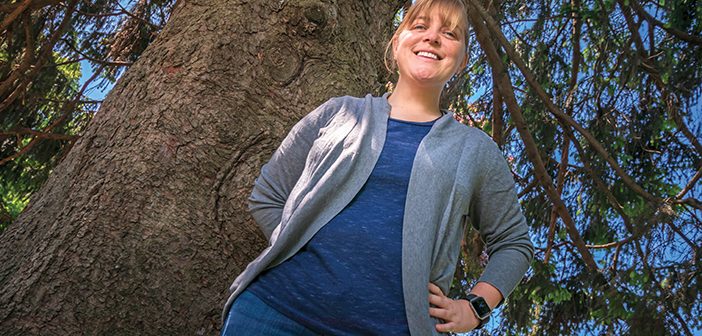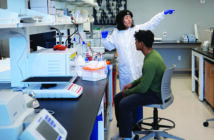An explosion of Lyme disease leaves some Rhode Islanders sick for months—and their doctors with a challenge.
When 33-year-old Jonathan Messier of Cumberland developed a high fever in July 2017, he didn’t think much of it. He spent the day in bed, and the next morning he felt fine. But two weeks later, Messier had developed rashes from head to toe.
“My wife took one look at me and said, ‘You’d better go to the hospital,’” Messier says.
Messier was just one of approximately 30,000 confirmed cases of Lyme disease in the United States last year, a number that has risen steadily over the past two decades. Despite its proliferation, Lyme remains difficult to diagnose and treat, and symptoms can linger for months to years.
Although Messier completed a course of antibiotics, his symptoms—fatigue, headaches, and anxiety—persisted.
“Instead of getting better, I went downhill fast,” Messier says. Looking for answers, Messier turned to the Lifespan Lyme Disease Center at The Miriam Hospital Immunology Center in Providence. The clinic has always treated infectious diseases, but was expanded in 2015 to treat patients coping with Lyme and other tick-borne illnesses as the number of cases increased. Most patients who are diagnosed with Lyme will recover fully after a few weeks of antibiotics; the clinicians at the Lyme Disease Center focus on treating those patients who don’t.
“The problem is patients have been told, ‘If you take antibiotics you’ll be fine,’ and that’s not always true,” says Rebecca Reece, MD, an assistant professor of medicine at the Warren Alpert Medical School. “We can address the healing process.”
Reece, who is an expert in Lyme disease, joined the Medical School in 2011 to complete a fellowship in infectious disease. She and her colleagues at the center focus on offering patients a holistic approach to treatment, one that includes a team of behavioral health specialists and physical therapists as well as a non-inflammatory diet and regular exercise. The center is well equipped to treat patients like Messier, who are seeking help with post-treatment Lyme disease syndrome.
“The later you are diagnosed with Lyme, the longer it takes to fully recover. But it is possible,” Reece says.
Lyme disease is caused by a spirochete bacterium and is passed to humans via the bites of infected blacklegged ticks. Unlike with other tick-borne diseases, the bacteria that cause Lyme travel from the bloodstream into the tissue, unleashing destruction and inflammation. Although antibiotics can kill the bacteria, they can’t heal the damage that Lyme causes to the body’s tissue.
Because the bacteria leaves the bloodstream, Lyme cannot be detected through a blood test. The only reliable way to test for Lyme is to measure antibodies that the body creates in reaction to the infection. But the human body takes two to three weeks to develop Lyme antibodies, so health care professionals can miss a diagnosis.
“That’s where there’s confusion for doctors and patients. People wonder, ‘Am I still infected?’” Reece says.
It’s also difficult to determine whether treatment has been effective. After the body develops antibodies to Lyme, it holds on to them, and a person will continue to test positive for many years after the first bout with the disease. A patient can be infected with Lyme more than once with subsequent tick bites, but re-infection can be difficult to confirm since a test can remain positive from a prior infection, Reece says.
A STEADY UPTICK
According to the US Centers for Disease Control and Prevention (CDC), from 2012 to 2013 the number of reported cases of Lyme disease in Rhode Island increased significantly, from 133 to 444. The jump is due in part to changes in state law around reporting cases of Lyme. Prior to 2013, physicians voluntarily reported confirmed cases to the CDC. Now they’re required to report any positive test for Lyme to the state Department of Health, along with details about the patient’s symptoms.
Due to underreporting and misdiagnoses, however, health officials don’t have a full picture of the extent of the disease. State health departments report about 30,000 cases of Lyme disease to the CDC every year. But the agency estimates as many as 300,000 people in the US are infected annually, most in the Northeast and upper Midwest. And these numbers are likely to go up.
“With global warming, we don’t have as many sustained cold days, so more ticks are surviving the winter, which leads to more breeding,” Reece says.
The expansion of human populations into heavily wooded areas—ticks’ natural habitat—also leads to more tick bites.
Despite the prevalence of Lyme disease—it is the most commonly reported vector-borne disease in the US—there’s still a lot we don’t understand. The majority of patients who are infected do not recall being bitten by a tick. The common symptoms of the disease—fatigue, muscle soreness, or feeling “disconnected”—can seem generic and even harmless.
“A lot of doctors don’t want to talk about Lyme because it’s frustrating. We try to approach each patient as best we can and acknowledge how much is still unknown,” says Timothy Flanigan, MD, a professor of medicine and of health services, policy, and practice at Brown.
LONG ROAD TO RECOVERY
Like Reece, Flanigan treats patients at the Lifespan Lyme Disease Center, guiding them through a care program that focuses on improving their overall health and easing their symptoms through diet and exercise. Some patients report finding relief through acupuncture, physical therapy, sleep medications, and even CBD cream, a lotion that is infused with one of the active ingredients in marijuana.
“We want them to explore these options. We’re learning while they’re learning,” Flanigan says.
Despite the challenges associated with diagnosing and treating Lyme, Reece and Flanigan remain optimistic that testing for the disease will improve, allowing doctors to catch it early, before it causes severe inflammation. In addition to treating patients, physicians at the center conduct clinical research and educate the public on how to prevent Lyme and other tick-borne illnesses and how to recognize the symptoms.
“I started my career working on HIV, and we’ve seen extraordinary progress there,” Flanigan says. “I’m comfortable being in a place where I can’t necessarily cure patients, but can provide significant help.”
Not all of the patients at the center improve, Reece says, but the vast majority of them are able to find some relief and get better, some of them significantly so.
“We ask, ‘Are we improving their quality of life?’ There isn’t a guideline. It’s about what’s important to the patient,” Reece says.
Messier first visited the center in January and has seen Reece twice since then. He says his symptoms have improved exponentially with every visit, and Reece has helped him to stay positive, follow a diet, and be more active.
“I’m about 80 to 85 percent better than I was at my first visit,” Messier says. “[Reece] was confident that my symptoms would get better. That lifted a lot of weight off my shoulders.”




